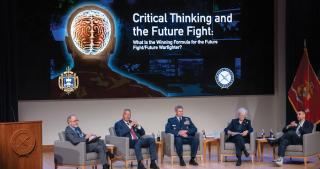The importance of history was evident in the seminar on critical thinking held by the U.S. Naval Institute and U.S. Naval Academy at the Jack C. Taylor Conference Center in Annapolis on 25 October.
Leading off the discussion was a panel consisting of Dr. Andrew Ledford, Chair of the Naval Academy’s Leadership, Ethics and Law Department; Dr. Mark Hagerott, Chair of the Secretary of the Navy’s Education Task Force, and award-winning historian Trent Hone.
To answer the question, “What is the winning formula for future warfighters?” the panelists reviewed some of the history of critical thinking in the Navy’s officer corps both before and after World War II.
Hone recalled that on the eve of World War II, naval officers “had become habituated to think critically and to problem solve both as individuals and as a team.” He cited as examples the development of the combat information center (CIC) in surface ships and the creation of the “Thach Weave” to overcome the advantage held early in the war by Japanese fighter aircraft. He emphasized that crucial to this process was the Americans’ ability to stay inside the Japanese decision-making cycle, a factor that likely allowed the war to be won more quickly.
This idea was later expanded by Marine Major General William F. Mullen III, who began his remarks in the second panel of the day by telling the audience that the key to winning in today’s environment is to seize the initiative and stay ahead of the enemy by outthinking them, referring to the “OODA Loop” developed by Air Force Colonel John Boyd that prescribes the recurring sequence of “observe, orient, decide, act.”
Hagerott delved into the postwar struggle over technical vs. liberal education, citing the roles of Alfred Thayer Mahan and Ernest J. King in emphasizing the need for officers who were holistically educated rather than focused on specialization. He explained that, despite the concurrence of several important reports that emerged in the postwar years, the sinking of the submarine USS Thresher (SSN-593) changed the direction of naval education, particularly at the Naval Academy.
Recognizing the need for technical education to produce officers prepared to safely harness nuclear propulsion, Admiral Hyman Rickover was able to change the emphasis of naval education from the holistic approach to a highly technical one that continues to dominate the curriculum at the Naval Academy today. By 1973, Rickover was able to achieve his goal of making virtually every Naval Academy graduate—regardless of major—potentially able to attend nuclear power training.
Other participants in the day’s events included Naval Academy Provost Samara Firebaugh, former Deputy Secretary of Defense Robert Work, former Secretary of Defense General James Mattis, President of the Defense University Lieutenant General Michael Plehn, President of the Naval Postgraduate School Vice Admiral Ann Rondeau, Chairman of the National Security Commission on Artificial Intelligence Dr. Eric Schmidt, Strategist and Senior Fellow at News America Dr. Peter Warren Singer, and Paul Scharre, author of Four Battlegrounds: Power in the Age of Artificial Intelligence. Also included were Naval Academy midshipmen who actively participated on both sides of the podium.
—Lieutenant Commander Thomas J. Cutler, U.S. Navy (Retired)







